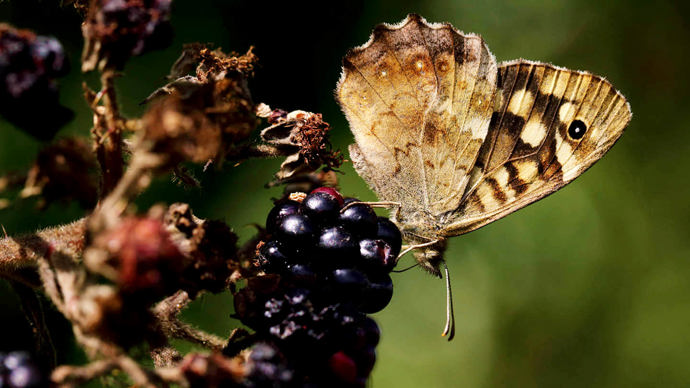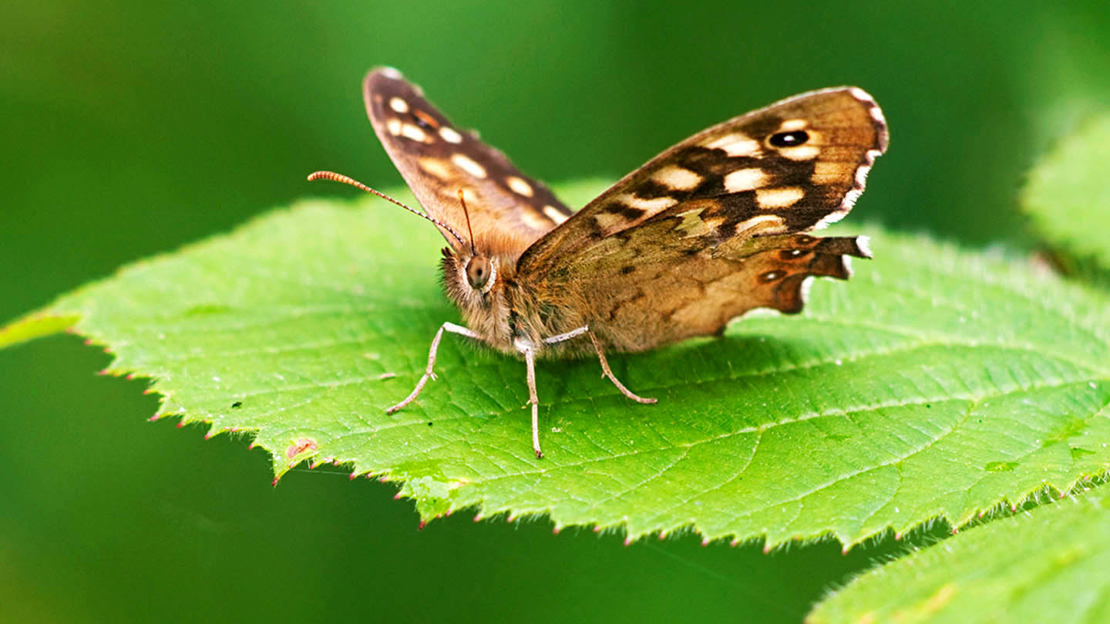Common names: speckled wood, Enfield eye, wood argus
Scientific name: Pararge aegeria
Family: Nymphalidae
Habitat: woodland, grassland, urban areas, parks and pasture
Caterpillar foodplants: grasses
Predators: birds and small mammals
Origin: native
Understated yet headstrong, the speckled wood spends its time basking in sun-dappled woodland and fiercely patrolling its patch.
Common names: speckled wood, Enfield eye, wood argus
Scientific name: Pararge aegeria
Family: Nymphalidae
Habitat: woodland, grassland, urban areas, parks and pasture
Caterpillar foodplants: grasses
Predators: birds and small mammals
Origin: native
Adult: the speckled wood has chocolate-brown wings with creamy-yellow eye spots. There is one black and white eye spot on the forewing and three on the hind.
Caterpillar: speckled wood caterpillars are bright green with faint dark green and yellow stripes.

Credit: Ian Johnston / Alamy Stock Photo
Speckled wood butterflies are active during the day and feed on aphid honeydew, a sugary liquid excreted by small insects when they feed on plants. They also feed on flowers and fruits when aphid activity is low.
Their caterpillars feed on false brome, Yorkshire fog grass and other grasses.
Unlike other native butterflies, the speckled wood can hibernate as a caterpillar or as a chrysalis.
Females are very choosy; they only mate once in their short lives, so it has to count! Males are fiercely territorial. If one strays into a rival's territory they will both spin through the woodland understorey in combat until one is bested.
Eggs are laid on the food plant of the caterpillars, usually on the underside of the leaf. They hatch after one to three weeks depending on the weather. The hatched caterpillar will live and feed on the food plant, and can overwinter in the plant's base. It will go through phases of development, known as instars, and then pupate after about a month.
There are usually two generations of speckled wood per year, one in spring and one in summer.
These butterflies are common and widespread across the UK, though less common in Scotland. You can spot them in woodland glades and rides, parks, hedgerows, and gardens between April and September.
Look out for speckled wood butterflies longing in patches of sun in shaded woodland. They seem to prefer slightly damper areas so keep an eye out around patches of tall grass and shady spots.
Caterpillars and pupa are harder to spot as they're both bright green. Keep a careful eye out for them in grasses.
In some cultures, a brown butterfly entering the house is a bad omen. They are also a thought to be messengers from the underworld in folklore from around the world.

Speckled wood numbers fell in the early 20th century, but have recovered in recent years. That said, they are still threatened by loss of suitable habitats. You can help pollinators like the speckled wood butterfly by planting trees or letting part of your garden grow wild.